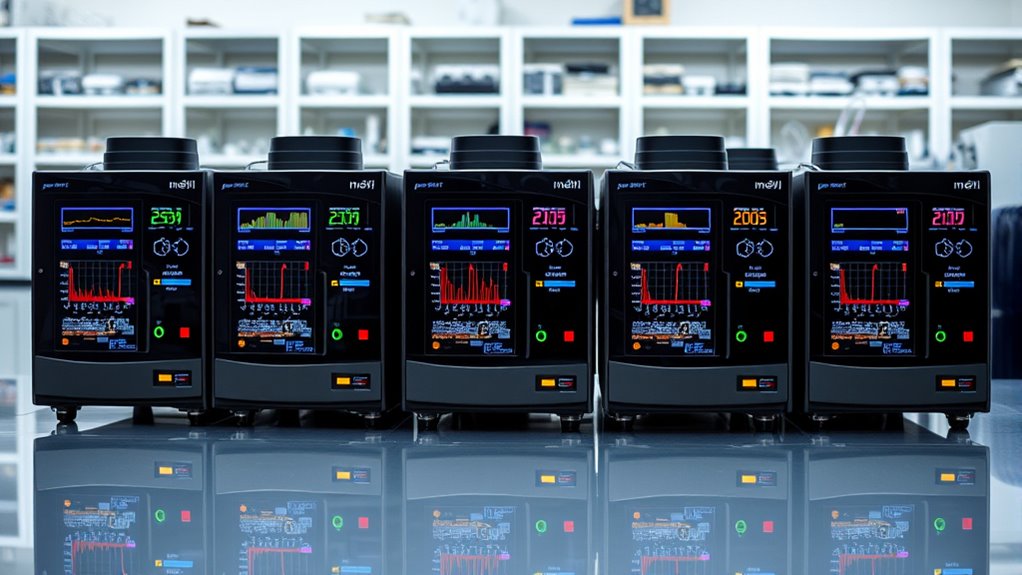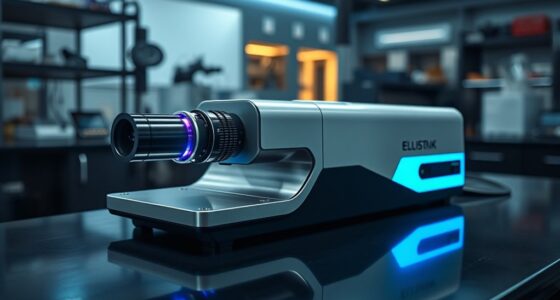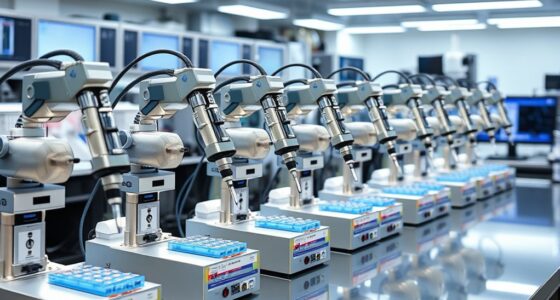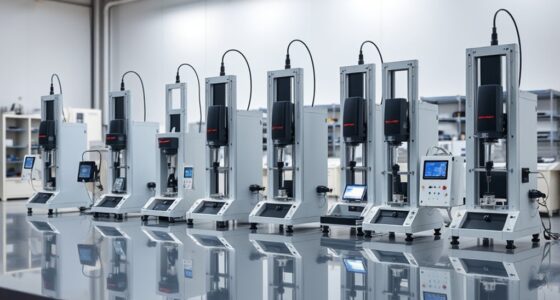If you’re looking for the top high-performance gas chromatographs of 2025 for precision analysis, I recommend several models known for their advanced features, sensitivity, and reliability. These systems balance speed, detection limits, and upgrade options, making them ideal for rigorous labs. Additionally, their durability and ease of maintenance help guarantee consistent results over time. Keep exploring further, and you’ll uncover detailed insights into these cutting-edge chromatographs that could transform your analytical capabilities.
Key Takeaways
- Prioritize GC systems with high sensitivity detectors like MS for trace-level precision analysis.
- Select models with modular design features for future upgrades and customizable configurations.
- Opt for instruments with fast temperature ramping and high carrier gas flow to enhance analytical speed.
- Ensure compatibility with diverse sample injection methods and sample matrices for versatile applications.
- Consider durability, maintenance ease, and calibration capabilities to sustain long-term high-performance operation.
StonyLab Glass Chromatography Column, Borosilicate Glass 24/40 Joint
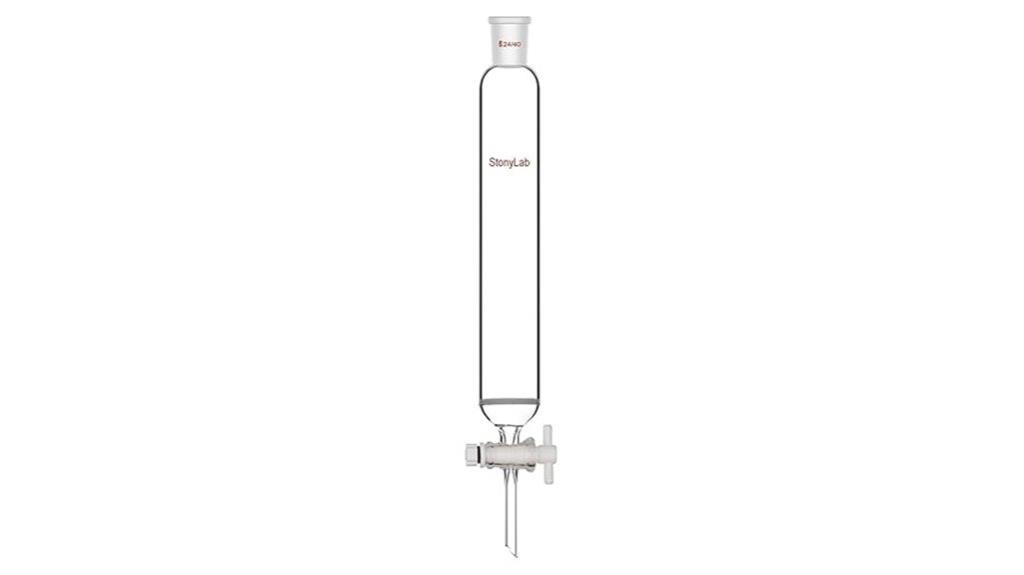
If you’re looking for a reliable chromatography column that combines durability with high performance, the StonyLab Glass Chromatography Column with a 24/40 joint is an excellent choice. Crafted from borosilicate glass, it offers strength and chemical resistance. With a 50mm outer diameter and 300mm length, it’s versatile for various applications. The included fritted disc ensures even flow, while the PTFE stopcock provides precise control. Handcrafted through glass blowing, it guarantees top-notch performance. Plus, its standard taper top outer joint makes it compatible with many setups. StonyLab’s quality assurance and customer support make this column a dependable tool for your analytical needs.
Best For: researchers and laboratory professionals seeking a durable, high-performance chromatography column compatible with various analytical setups.
Pros:
- Made from borosilicate glass for enhanced durability and chemical resistance
- Handcrafted by glass blowing for optimal performance and quality assurance
- Equipped with a fritted disc and PTFE stopcock for precise flow control
Cons:
- May be heavier than plastic alternatives due to borosilicate glass construction
- Requires careful handling to prevent breakage during use or transport
- Compatibility limited to standard 24/40 taper connections, which may not suit all setups
Stonylab Portable UV Analyzer for Laboratory Testing

The Stonylab Portable UV Analyzer is an ideal choice for laboratories that require precise and reliable UV light intensity measurements, especially during thin-layer chromatography and fluorescent dye testing. Its white housing assures excellent visibility, making it easy to monitor during experiments. Built with a durable metal construction, it withstands demanding lab environments. The device features high-quality quartz glass UV lamps with adjustable short-wave (254nm) and long-wave (365nm) light sources, providing stable illumination for accurate results. Designed for continuous operation, it delivers consistent performance. If you receive a damaged unit, prompt customer support is available to help you quickly resolve any issues.
Best For: laboratories conducting thin-layer chromatography and fluorescent dye testing requiring precise UV light measurements and durable equipment.
Pros:
- High-quality quartz glass UV lamps with adjustable short-wave and long-wave options for versatile testing.
- Durable metal housing ensures robustness in demanding laboratory environments.
- Stable illumination provides consistent and reliable results for research and chemical analysis.
Cons:
- Limited to UV light intensity measurement; not suitable for other types of spectroscopy.
- Requires careful handling to avoid damage, especially during transportation or use in rugged conditions.
- May need calibration over time to maintain optimal accuracy and performance.
Aldon Science Paper Chromatography Kit
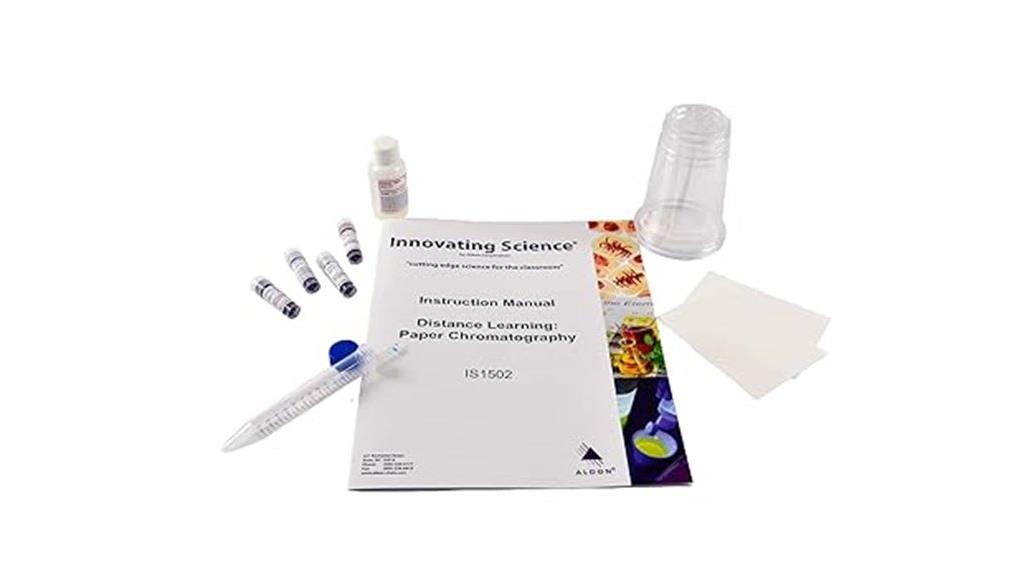
Looking for an engaging, hands-on way to introduce students to chromatography? The Aldon Science Paper Chromatography Kit is perfect. It offers a straightforward demonstration where students analyze three dyes and a dye mixture, helping them grasp how substances separate and move at different rates. The kit includes all essential materials—chromatography sheets, dyes, ethanol, and tools—making setup simple and thorough. Designed for remote learning, it comes with instructions and worksheets, encouraging active participation. This kit fosters a clear understanding of chemical separation and chromatography principles, making it an excellent educational resource for learners of all levels.
Best For: educators and students seeking an engaging, hands-on introduction to chromatography, especially suitable for remote learning environments.
Pros:
- Provides a comprehensive, all-in-one kit for practical chromatography experiments
- Includes detailed instructions and worksheets to facilitate remote or classroom learning
- Encourages active participation and deeper understanding of chemical separation processes
Cons:
- May require supervision to ensure proper handling of chemicals and tools
- Limited to analyzing specific dyes and mixtures, which could restrict broader applications
- Some users might find the set-up and materials sufficient for only a few experiments before needing replacements
Lab Media Storage Round Bottles with GL45 Screw Cap, Leakproof, 2000ml (Pack of 1, Blue)
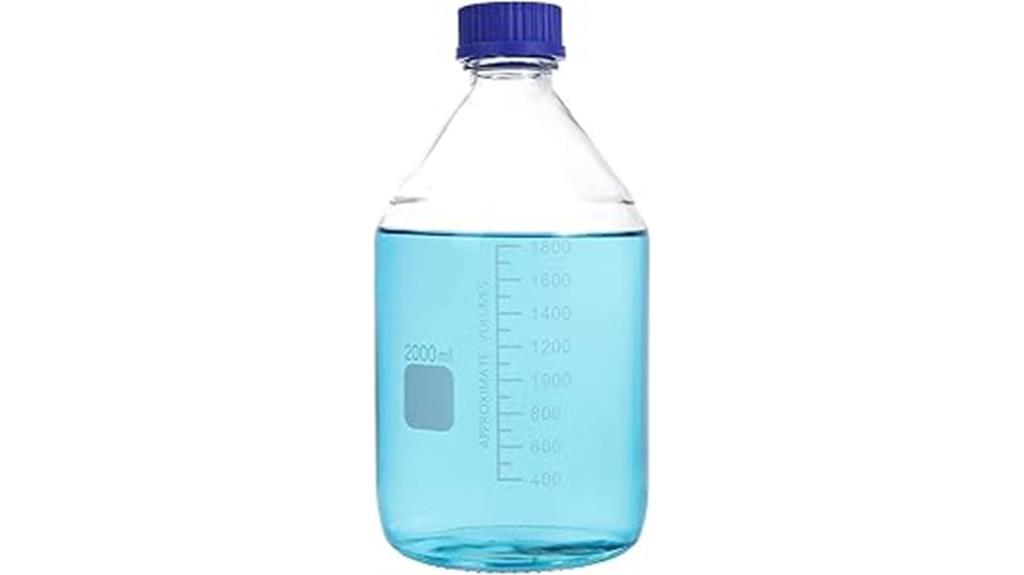
High-performance gas chromatographs demand reliable sample storage solutions, and these lab media storage round bottles are an ideal choice. Made of high-quality, transparent glass, they hold 2000 mL of liquids, perfect for various laboratory and industrial applications. The thick, sturdy glass resists thermal shock and chemicals, ensuring durability. The GL45 screw cap provides a leakproof seal, preventing spills and evaporation, while the drip-free pouring ring enhances ease of use. Autoclavable for sterilization, these bottles are reusable and environmentally friendly. Their clear measurement scales facilitate accurate labeling, making them a dependable, versatile option for precise sample storage in demanding analytical environments.
Best For: researchers, scientists, and laboratory technicians requiring reliable, durable, and precise sample storage solutions for chemical, biological, or industrial liquids.
Pros:
- Made of high-quality, impact-resistant glass with chemical and thermal shock resistance.
- Leakproof GL45 screw cap with drip-free pouring ring ensures secure storage and easy dispensing.
- Autoclavable and reusable, promoting sterilization and environmental sustainability.
Cons:
- Rated 3.5 out of 5 stars, indicating mixed customer reviews on overall satisfaction.
- Limited to a single bottle per pack, which may require purchasing multiple units for larger needs.
- Dimensions and weight may not be optimal for all storage or transport situations.
Sylvan HX-3000 Hydroxyl Generator with Optional Ozone Machine
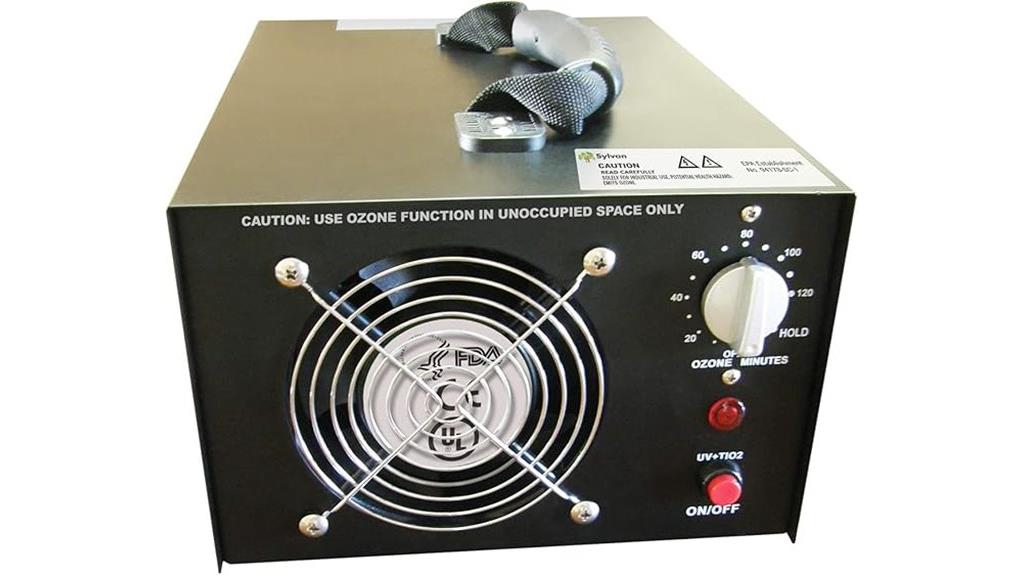
If you’re in professional water and fire restoration, the Sylvan HX-3000 Hydroxyl Generator stands out because of its powerful and versatile air purification features. Its compact design (8 1/4 x 7 x 6 inches, 5 lbs) makes it easy to move around job sites. It produces environmentally friendly hydroxyl radicals using a resistive Anatase TiO2 Mega Reactor Shield, neutralizing pollutants safely in occupied spaces. The optional ozone function (3500 mg/hr) enhances cleaning by breaking down odors, bacteria, and viruses, with a timer and hold feature for control. This industrial-grade device offers a reliable, residue-free solution for all-encompassing air purification during restoration projects.
Best For: professional water and fire restoration experts seeking a powerful, versatile, and environmentally friendly air purification solution for occupied spaces.
Pros:
- Compact and portable design (8 1/4 x 7 x 6 inches, 5 lbs) for easy mobility on job sites
- Combines hydroxyl radical and optional ozone generation for comprehensive air cleaning
- Safe for occupied environments in hydroxyl-only mode, with environmentally friendly technology
Cons:
- Manufactured exclusively for industrial and professional use; not suitable for residential applications
- Requires verification of proper use to ensure compliance with restrictions
- Ozone feature may require careful handling and monitoring due to its strong oxidizing properties
Phrozen FR940 Functional Resin for 3D Printing
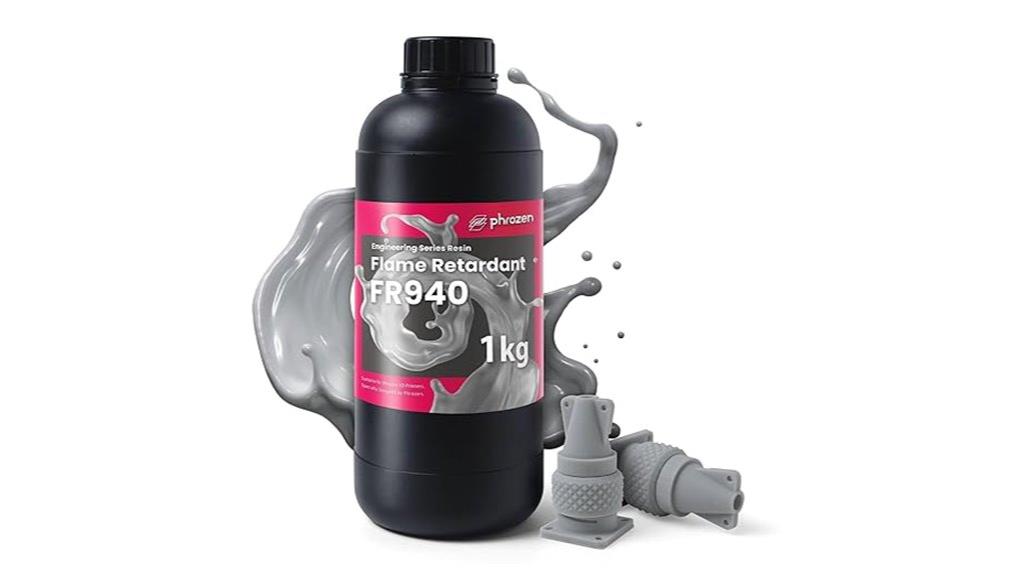
Are you searching for a 3D printing resin that combines safety with high-temperature performance? I recommend Phrozen FR940 Functional Resin. It’s designed for demanding environments like automotive, machinery, and electronics. Packaged in a leakproof bottle, it guarantees safety during storage and use. Its flame-retardant properties can diffuse flames within 10 seconds, and it’s the first resin in Asia to earn UL 94-0 Blue Card certification, confirming its safety standards. This versatile resin provides excellent high-temp resistance and meets rigorous industry requirements. Plus, Phrozen offers professional support to help you achieve precise results, making FR940 a reliable choice for critical applications.
Best For: professionals and industries requiring high-temperature, flame-retardant 3D printed parts such as automotive, machinery, and electronic device manufacturers.
Pros:
- Excellent flame-retardant capabilities with rapid diffusion of flames within 10 seconds
- Certified with UL 94-0 Blue Card, ensuring compliance with rigorous safety standards
- Versatile for various demanding applications, including automotive, electronics, and machinery
Cons:
- May require specialized handling and safety precautions during printing and post-processing
- Higher cost compared to standard resins due to its safety and performance features
- Limited color options, primarily designed for functional rather than aesthetic purposes
Factors to Consider When Choosing High‑Performance Gas Chromatographs

When selecting a high-performance gas chromatograph, I focus on detection sensitivity levels and how they match my analytical needs. I also consider the speed of analysis, sample compatibility, and the instrument’s durability to guarantee reliable long-term use. Finally, I evaluate maintenance requirements and calibration processes to keep the system running smoothly.
Detection Sensitivity Levels
Understanding what influences detection sensitivity levels is essential when selecting high-performance gas chromatographs. Sensitivity depends on the instrument’s ability to detect small analyte quantities amid background noise, enabling identification of trace compounds at parts-per-trillion or even parts-per-quadrillion levels. The choice of detector plays a key role; mass spectrometry offers high sensitivity, while flame ionization provides reliable detection for organic compounds. Additionally, factors like column efficiency, carrier gas purity, and injection techniques impact overall sensitivity. Regular calibration and maintenance are necessary to maintain peak detection limits over time. When evaluating GC systems, consider how these factors align with your analytical needs, especially if detecting ultra-trace levels is critical. A well-balanced instrument tailored to your sensitivity requirements ensures precise, reliable results.
Analytical Speed Requirements
Selecting a high-performance gas chromatograph requires balancing analysis speed with the level of separation and sensitivity you need. Fast analysis speeds improve throughput but can risk compromising resolution if not properly optimized. To achieve rapid results, some models use high carrier gas flow rates or shorter columns. Advanced instruments incorporate fast temperature ramping and high-efficiency columns, considerably reducing analysis time while maintaining accuracy. Your specific application influences speed requirements—routine quality control may demand quick turnarounds, whereas detailed research might prioritize resolution over speed. It is crucial to evaluate these factors carefully, ensuring the instrument can deliver the needed balance of speed and separation quality. Ultimately, choosing the right chromatograph depends on understanding your analytical goals and the trade-offs involved in speed versus resolution.
Sample Compatibility Features
Choosing the right high-performance gas chromatograph hinges on its ability to handle a variety of sample types effectively. I look for systems that support multiple injection methods like split, splitless, and on-column, ensuring flexibility for different samples. Temperature control is crucial; the device should accommodate the thermal stability and volatility of various matrices. Detector options matter too—whether flame ionization, mass spectrometry, or thermal conductivity—to match the chemical properties of my samples. Handling different sample volumes and viscosities is essential for versatility, especially when working with both small and complex samples. Finally, compatibility with sample preparation accessories, such as autosamplers and vials, ensures seamless workflow integration, making the system adaptable to diverse analytical needs.
Instrument Durability Factors
When evaluating high-performance gas chromatographs, durability is a key factor that can’t be overlooked. I look for instruments built from robust materials like borosilicate glass and high-quality metal housings that resist chemical exposure and mechanical stress. Construction quality matters, especially reinforced joints and leakproof seals, to guarantee long-term operation in demanding environments. Resistance to thermal shock and corrosive substances is essential for maintaining consistent performance during repeated heating cycles and exposure to aggressive chemicals. Automated calibration and self-diagnostic features help reduce wear and tear by keeping the instrument running at its best, extending its lifespan. Proper protection from dust, moisture, and physical impacts also plays a vital role in enhancing durability, guaranteeing the chromatograph remains reliable over time.
Maintenance and Calibration
How often you calibrate your gas chromatograph directly impacts its accuracy and reliability. Regular calibration corrects instrument drift and adjusts response factors, ensuring precise separation and quantification of analytes. Maintenance tasks like cleaning or replacing injection ports, detector cells, and columns prevent contamination and keep performance at excellent levels. It’s essential to use calibration standards traceable to certified reference materials and follow manufacturer or regulatory guidelines for intervals. Maintaining carrier gas purity and pressure is vital to avoid baseline noise and peak distortion, which can compromise data quality. Routine system checks for leaks, electrical connections, and detector sensitivity help sustain accuracy and extend instrument lifespan. Prioritizing consistent calibration and maintenance ensures your chromatography results remain precise, reliable, and compliant with industry standards.
Data Processing Capabilities
Effective data processing capabilities are vital for maximizing the performance of high-quality gas chromatographs. Advanced features like automated peak integration, baseline correction, and deconvolution ensure accurate interpretation of complex chromatograms and large datasets, reducing manual effort. The ability to export data in multiple formats—such as CSV, PDF, and chromatogram images—facilitates seamless integration with other analytical tools and workflows. Real-time data processing and reporting enable quick decision-making during analyses, increasing efficiency. Robust data storage and retrieval systems guarantee traceability and compliance with regulatory standards, which is indispensable in regulated environments. Overall, strong data processing capabilities enhance accuracy, speed, and compliance, making them a fundamental factor when selecting a high-performance gas chromatograph for precision analysis.
Budget and Cost Efficiency
Choosing the right high-performance gas chromatograph requires careful consideration of budget and cost efficiency. I look beyond the initial purchase price and evaluate the total cost of ownership, including maintenance and consumables like columns and detectors. Energy-efficient models help lower operational expenses over time, making them more economical. I also consider modular designs or upgrade options, which allow system enhancements without full replacements, saving money in the long run. Balancing my budget constraints with essential performance features ensures I get the analytical power I need without overspending on unnecessary capabilities. Additionally, I assess the availability and costs of consumables, since these ongoing expenses considerably impact long-term affordability. Making informed choices helps me optimize performance while maintaining cost efficiency.
Frequently Asked Questions
What Advancements Are Expected in Gas Chromatograph Sensitivity by 2025?
By 2025, I expect gas chromatograph sensitivity to markedly improve thanks to advances in detector technology, such as enhanced mass spectrometers and novel sensor materials. These innovations will allow me to detect trace compounds with greater accuracy and lower detection limits. Additionally, integration with AI-driven data analysis will boost sensitivity by optimizing parameters in real-time, ensuring I get precise results even from the tiniest sample quantities.
How Will Miniaturization Impact High-Performance Gas Chromatographs?
Miniaturization is like shrinking a powerful engine into a sleek, portable device, and I believe it’ll revolutionize high-performance gas chromatographs. It means I can carry precise analytical tools into remote locations, speeding up on-site decisions. Plus, smaller instruments often mean less sample volume and faster analysis. I see this advancement as opening new doors for fieldwork, making complex analysis more accessible, efficient, and adaptable than ever before.
What New Detection Technologies Will Be Integrated Into Future GC Systems?
I believe future GC systems will integrate advanced detection technologies like high-resolution mass spectrometry and enhanced optical sensors. These innovations will boost sensitivity and specificity, allowing us to identify compounds more accurately and quickly. Additionally, I expect to see AI-driven data analysis and miniaturized detectors that enable real-time, portable testing. This evolution will revolutionize how we perform complex analyses, making them faster, more precise, and more accessible.
How Will Software Improvements Enhance Data Analysis Accuracy?
Imagine the moment when software upgrades unlock hidden data insights—that’s exactly what’s coming. I believe these improvements will boost analysis accuracy by refining algorithms, reducing errors, and enabling real-time data processing. With smarter automation and advanced visualization tools, I’ll gain clearer, faster results. This boost in software performance promises to revolutionize precision analysis, making my work more reliable and insightful than ever before.
What Environmentally Friendly Features Are Being Developed for GCS?
I believe environmentally friendly features are a top priority in developing GCs. Manufacturers are working on reducing solvent consumption, incorporating energy-efficient components, and designing recyclable parts. Some models now use eco-friendly refrigerants and minimal power while maintaining high performance. These innovations help lower the carbon footprint and promote sustainable practices, making GCs more eco-conscious without sacrificing analytical precision.
Conclusion
Choosing the right gas chromatograph feels like selecting a trusted compass for uncharted territory—critical and precise. I remember a lab technician discovering a tiny impurity that earlier tests overlooked, thanks to a high-performance GC. That moment reminded me how these instruments are the navigators of accuracy in our work. Whether you’re analyzing complex samples or ensuring product purity, investing in top-tier GCs guarantees you stay on the right path toward reliable results.
